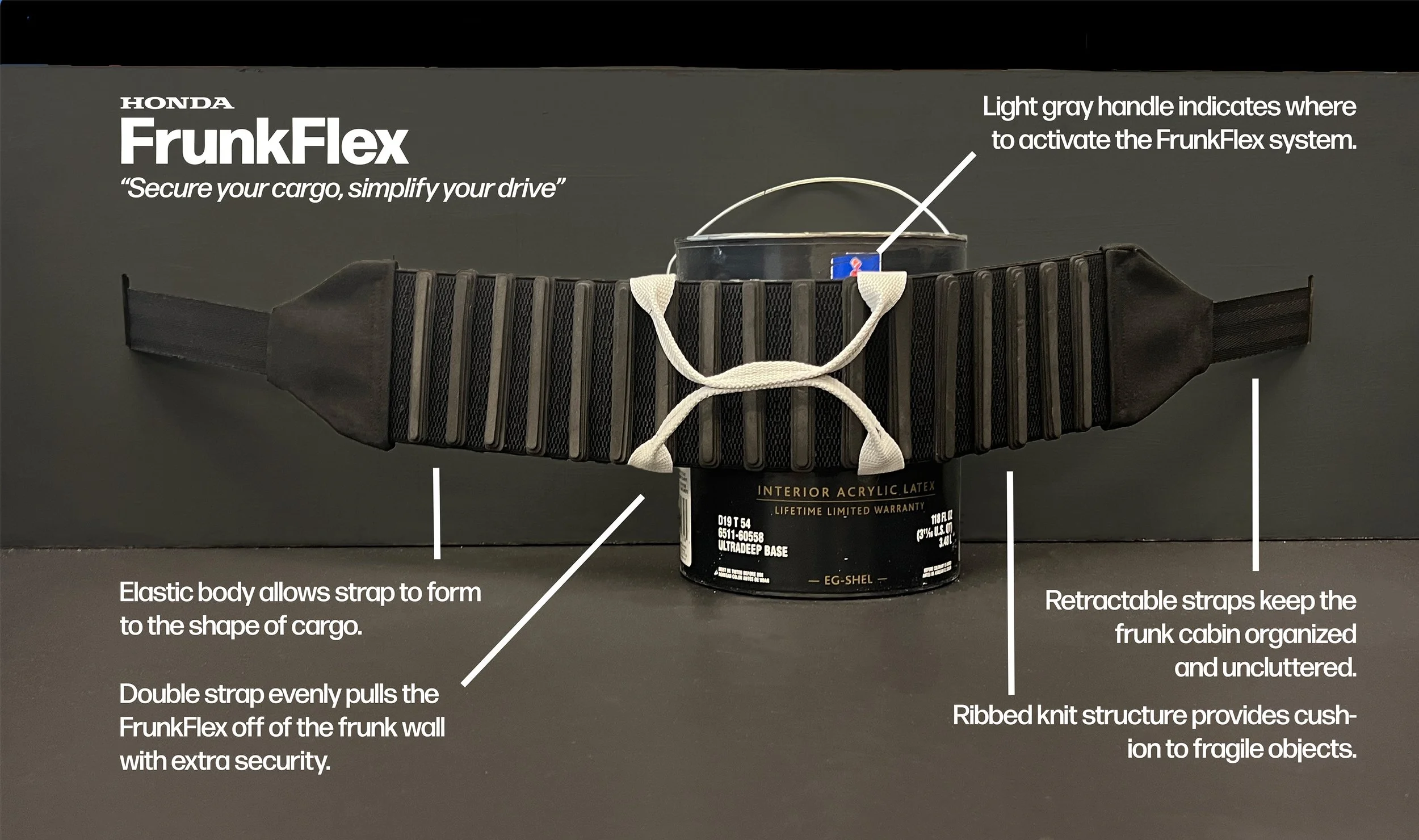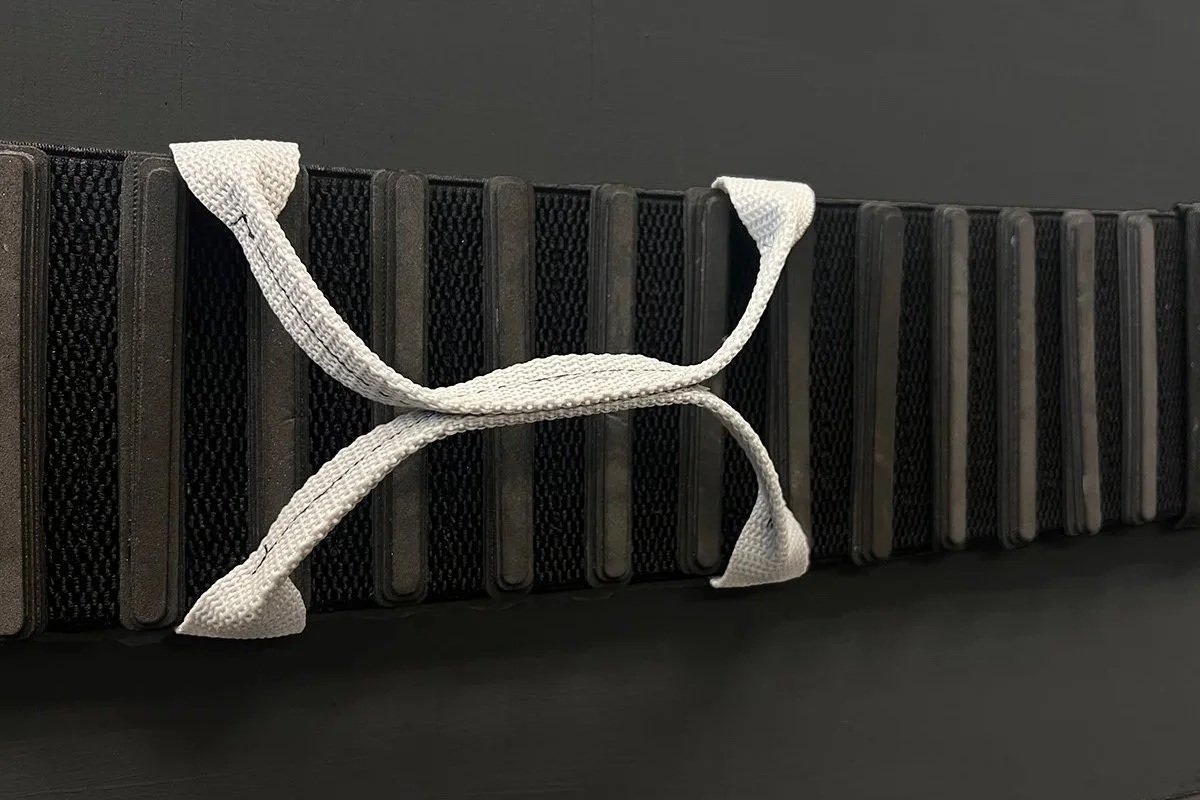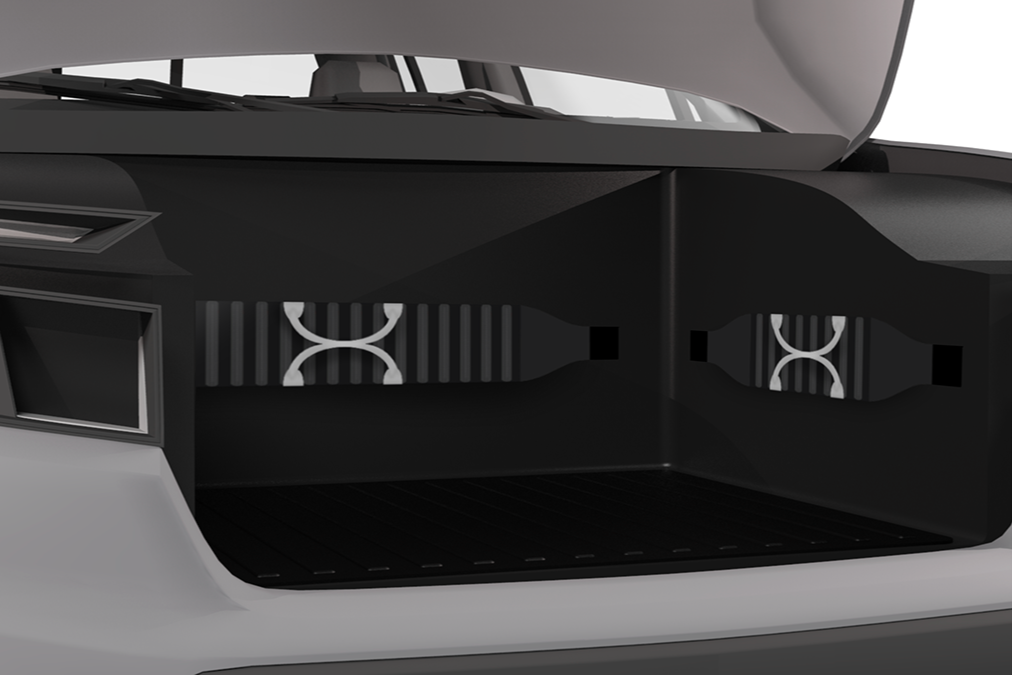FrunkFlex
“SECURE YOUR CARGO, SIMPLIFY YOUR DRIVE”
What if the storage in your car was as innovative as the vehicle itself? For my senior capstone project, I partnered with Honda Research and Development to reimagine the electric vehicle’s front trunk, or “frunk,” as a space that’s both functional and seamlessly integrated. My final concept, FrunkFlex, is a modular storage solution featuring flexible, cushioned straps designed to adapt to a variety of items and storage needs. With FrunkFlex, the frunk becomes just as innovative and functional as the rest of the EV. Simple, secure, and protected from the elements, FrunkFlex is built for the future of driving and is ready to revolutionize trunk transport.
15-week project | Role: Designer, Project Manager
Individual project within a team collaboration with Honda Research & Development
This project received a research distinction accreditation and completed my thesis project requirements for graduation from The Ohio State University.
Project Video
About the Project
The senior capstone serves as the culmination of The Ohio State University’s Industrial Design curriculum, bringing together the multitude of skills and knowledge gained throughout our undergraduate studies. This semester-long, sponsor-driven project challenges students to tackle real-world design problems with innovative solutions. In partnership with Honda Research and Development, my team was tasked with envisioning the future of the front trunk, or “frunk,” space in electric vehicles. Our objective was to explore how this emerging feature could enhance the functionality, convenience, and user experience of electric vehicles in meaningful ways.
Process Book
A key component of this project’s final deliverables was a comprehensive process documentation book. This book compiles the project’s goals and expectations, and provides a detailed account of each stage in the product development journey. From initial research and ideation to prototyping, testing, and refinement, the documentation serves as both a record of progress and a reflection of my design thinking.
Beyond simply outlining steps, the book highlights important insights, challenges, and decisions that shaped the final outcome. It functions as a resource for both the client and collaborators, offering transparency into the workflow while showcasing the rigor and creativity behind the project. By thoughtfully curating this documentation, I ensured that the development process could be understood, referenced, and built upon in the future.
FrunkFlex Prototype
During the development stage, I was encouraged to consider innovative materials that could elevate the final design. The Apple Vision Pro served as a key source of inspiration—its clean form, cushioned structure, and flexibility became reference points as I envisioned how the strap might function within the frunk space. This approach allowed me to prioritize both aesthetics and functionality, creating a solution that felt modern, durable, and adaptable to various storage needs.
To bring the FrunkFlex strap concept into a physical form, I developed a working prototype using 3-inch elastic, woven polyester canvas, and EVA foam. These materials were selected to balance strength, flexibility, and comfort, simulating how the final product might perform in a real vehicle context.
The wide elastic enabled the strap to stretch and retract as intended, while the canvas provided durability and a professional finish. EVA foam added structure and cushioning, ensuring the strap was both functional and user-friendly. Through this process, I was able to test the feasibility, ergonomics, and tactile qualities that would matter most to users.
This prototype became an essential tool in communicating the strap’s functionality during our senior showcase, where visitors could see firsthand how FrunkFlex would operate as part of the full-scale Ridgeline frunk model.
Full-Scale Ridgeline Prototype
Six weeks before our senior showcase, our professor challenged us to build a 1:1 scale model of the Honda Ridgeline frunk, the vehicle we were designing for. I stepped into the role of project manager, coordinating with our woodshop coordinator Paul Tenwalde, Design Department staff, and our Honda partners to make the model possible on a tight timeline.
I managed file acquisition, material purchasing, and scheduled CNC time, while also devising the construction strategy. The model was built by CNC cutting the vehicle’s profile from foam, which we then mounted to a wooden support structure. This process required significant upfront planning as well as hand carving and refinement after the main profiles were cut, ensuring accuracy and a professional finish. To keep the project on track, I organized our team’s shop time and assigned responsibilities throughout the build.
The finished full-scale model provided the ideal environment to showcase our FrunkFlex concepts in context. It became a central feature of our senior showcase at Urban Arts Space, where community members, faculty, and Honda representatives engaged with our work and offered feedback. The model not only elevated the presentation but also highlighted our team’s ability to bring a concept into a tangible, immersive experience.
Final Product
During the early stages of concept ideation I reflected on how many existing car storage solutions feel like an afterthought. They tend to be bulky, visually unappealing, and often require buyers to turn to third-party retailers for options that don’t always integrate well with the vehicle. The frunk, on the other hand, offers a fresh opportunity to rethink storage. Its unique location and potential for customization make it an ideal space for creating solutions that are both functional and seamlessly integrated into the vehicle’s design. This opened the door to exploring how storage could be better tailored to meet the needs of modern drivers.
Denman Undergraduate Research Forum
As part of my curriculum to graduate with research distinction, I presented this project at the Denman Undergraduate Research Forum, where I shared my process, findings, and outcomes through a research poster. Participating in the Denman allowed me to communicate my work to faculty, peers, and professionals, while also highlighting the depth of research and design exploration behind the project.










